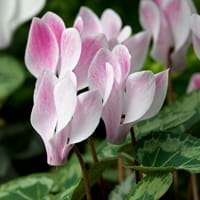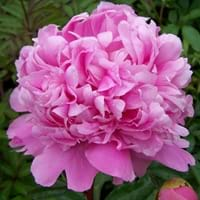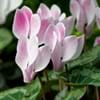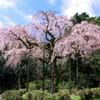Life Span
Perennial
Annual
Type
Flowering Plants, Tubers
Shrub
Origin
Europe, Mediterranean Basin, Middle East, North Africa, Somalia
China, Japan
Types
Cyclamen Africanum, Cyclamen Alpinum, Cyclamen Cilicium, Cyclamen Coum
Not Available
Habitat
Alpine Meadows, Rocky areas, Woods
Grassland, Woods
USDA Hardiness Zone
5-9
3-9
Sunset Zone
15, 16, 17, 18, 19, 20, 21, 22, 23, 24
A1, A2, A3, 1a, 1b, 2a, 2b, 3a, 3b, 4, 5, 6, 7, 8, 9, 10, 11, 14, 15, 16, 17, 18, 19, 20
Habit
Clump-Forming
Upright/Erect
Flower Color
Pink, Purple, White
Light Pink, Pink, White
Flower Color Modifier
Not Available
Not Applicable
Fruit Color
Brown
Brown, Brownish Red, Green
Leaf Color in Spring
Several shades of Green
Green, Light Green
Leaf Color in Summer
Not Available
Red, Green, Light Green
Leaf Color in Fall
Green, Silver
Red, Green, Light Green
Leaf Color in Winter
Green, Silver
Green
Leaf Shape
Heart-shaped
Arrowhead
Plant Season
Autumn, Spring, Summer, Winter
Early Fall
Sunlight
Indirect sunlight
Full Sun, Partial shade
Growth Rate
Medium
Medium
Type of Soil
Clay, Sandy, Well drained
Loamy, Well drained
The pH of Soil
Acidic
Neutral
Soil Drainage
Well drained
Moist
Bloom Time
Autumn, Spring, Summer
Early Summer, Late Spring, Spring, Summer
Tolerances
Not Available
Cold climate, Heat Tolerance
Where to Plant?
Container, Ground, Pot
Ground, Pot
How to Plant?
From bulbs, Seedlings
Budding
Plant Maintenance
Medium
Medium
Watering Requirements
Do not water frequently, It cannot sustain wet-feet, Keep the ground moist but not water-logged, Prefer drip-irrigation instead of Over-head watering, Water when soil is dry
Requires regular watering
In Summer
Lots of watering
Lots of watering
In Spring
Moderate
Moderate
In Winter
Average Water
Average Water
Soil Type
Clay, Sandy, Well drained
Loam
Soil Drainage Capacity
Well drained
Well drained
Sun Exposure
Indirect sunlight
Full Sun, Partial Sun
Pruning
Cut or pinch the stems, Prune if you want to improve plant shape, Prune ocassionally, Prune to control growth, Prune when plant is dormant, Remove dead leaves, Remove dead or diseased plant parts
Remove damaged leaves, Remove dead branches, Remove dead leaves
Fertilizers
All-Purpose Liquid Fertilizer
All-Purpose Liquid Fertilizer
Pests and Diseases
Aphids, Botrytis Cinerea, Gray mold, Mice, Mites, Root weevil, Slugs, Snails, Squirrels
Botrytis Blight, Nematodes, Ring spot, Stem rot, Verticillium Wilt
Plant Tolerance
Drought
Drought
Flower Petal Number
Single
Not Available
Foliage Texture
Medium
Coarse
Foliage Sheen
Matte
Glossy
Attracts
Not Available
Ants
Allergy
Respiratory problems
Abdominal pain, Avoid during Pregnancy, Stomach pain, Vomiting
Aesthetic Uses
Showy Purposes
Landscape Designing, Showy Purposes
Beauty Benefits
Not Available
Not Available
Environmental Uses
Air purification
Air purification
Medicinal Uses
Digestive disorders, Menstrual Disorders
Atherosclerosis, Chronic fatigue, Cold, Cough, Gout, Headache, hemorrhoids, Hepatitis, Liver problems, Menstrual Cramps, Muscle Pain, Nerve pain, Osteoarthritis, Premenstrual syndrome, Respiratory Disorders, Treating fever
Part of Plant Used
Root, Stem
Flowers, Root, Seeds
Other Uses
Showy Purposes, Used as an ointment
Showy Purposes, Traditional medicine, Use in Chinese herbology
Used As Indoor Plant
Yes
Sometimes
Used As Outdoor Plant
Yes
Yes
Garden Design
Not Available
Cutflower, Feature Plant, Foundation, Mixed Border
Botanical Name
Cyclamen Persicum
Paonia lactiflora
Common Name
Cyclamen or Florist's Cyclamen
Chinese Peony
In Hindi
Sikalemen
Paonia lactiflora
In German
Zyklamen
Paonia lactiflora
In French
Cyclamen
Paonia lactiflora
In Spanish
Ciclamen
lactiflora paonia
In Greek
κυκλάμινο
Paonia lactiflora
In Portuguese
Cíclame
Paonia lactiflora
In Polish
Cyklamen
Paonia lactiflora
In Latin
Cyclamīnos
Paonia lactiflora
Phylum
Anthophyta
Magnoliophyta
Class
Dicotyledonae
Magnoliopsida
Order
Ericales
Dilleniales
Family
Primulaceae
Paeoniaceae
Clade
Not Available
Angiosperms, Core eudicots, Eudicots
Tribe
Cyclamineae
Not Available
Subfamily
Myrsinoideae
Not Available
Season and Care of Cyclamen and Paeonia Lactiflora
Season and care of Cyclamen and Paeonia Lactiflora is important to know. While considering everything about Cyclamen and Paeonia Lactiflora Care, growing season is an essential factor. Cyclamen season is Autumn, Spring, Summer and Winter and Paeonia Lactiflora season is Autumn, Spring, Summer and Winter. The type of soil for Cyclamen is Clay, Sandy, Well drained and for Paeonia Lactiflora is Loamy, Well drained while the PH of soil for Cyclamen is Acidic and for Paeonia Lactiflora is Neutral.
Cyclamen and Paeonia Lactiflora Physical Information
Cyclamen and Paeonia Lactiflora physical information is very important for comparison. Cyclamen height is 0.54 cm and width 0.75 cm whereas Paeonia Lactiflora height is 91.50 cm and width 91.50 cm. The color specification of Cyclamen and Paeonia Lactiflora are as follows:
Cyclamen flower color: Pink, Purple and White
Cyclamen leaf color: Several shades of Green
Paeonia Lactiflora flower color: Light Pink, Pink and White
- Paeonia Lactiflora leaf color: Green, Light Green
Care of Cyclamen and Paeonia Lactiflora
Care of Cyclamen and Paeonia Lactiflora include pruning, fertilizers, watering etc. Cyclamen pruning is done Cut or pinch the stems, Prune if you want to improve plant shape, Prune ocassionally, Prune to control growth, Prune when plant is dormant, Remove dead leaves and Remove dead or diseased plant parts and Paeonia Lactiflora pruning is done Remove damaged leaves, Remove dead branches and Remove dead leaves. In summer Cyclamen needs Lots of watering and in winter, it needs Average Water. Whereas, in summer Paeonia Lactiflora needs Lots of watering and in winter, it needs Average Water.





